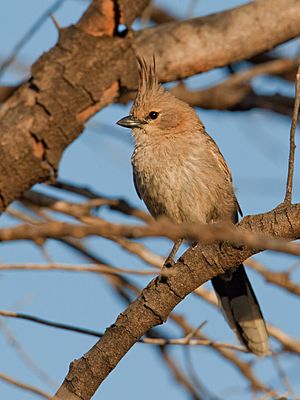Chirruping wedgebill facts for kids
Quick facts for kids Chirruping wedgebill |
|
|---|---|
 |
|
| Conservation status | |
| Scientific classification | |
| Genus: |
Psophodes
|
| Species: |
cristatus
|
The chirruping wedgebill (Psophodes cristatus) is a medium-sized songbird. It lives only in Australia. This bird is known for its special "chirruping" call. You can often find it in low, bushy areas in south-eastern Australia.
Until 1973, people thought the chirruping wedgebill and the chiming wedgebill were the same bird. But scientists noticed their calls were very different. So, they decided they were two separate species.
Contents
About the Chirruping Wedgebill
The chirruping wedgebill is a medium-sized bird. It is about 18 to 21 centimeters long. It weighs between 31 and 64 grams. Young birds have a horn-colored beak. Adult birds have a dark, wedge-shaped beak.
This bird has a thin crest that stands up. It also has a long, rounded tail. Its upper body is pale brown. Its belly is white or light grey. The feathers on its wings have white edges. Its tail is dark black-brown with a white tip. Young birds look similar. Their wing feathers have buff-colored tips instead of white ones.
People sometimes confuse this bird with the chiming wedgebill. You can tell them apart by a few things. The chirruping wedgebill has faint streaks on its chest. It also has a slightly longer tail. Most importantly, it has a repeated chirruping call.
What Does It Sound Like?
The chirruping wedgebill has a very unique call. It's like a duet between the male and female. Some people describe the male's call as 'sitzi-cheeri'. It sounds a bit like a budgerigar. The female then replies with an upward rolling 'r-e-e-e-t CHEER'.
Other people describe the call differently. They say it sounds like a sparrow. The male calls 'chirrrp'. The female then answers with 'ee cheer'.
Where Do They Live?
You can find the chirruping wedgebill in south-eastern inland Australia. They live in low, open shrublands. These areas often have acacia trees. They are not found everywhere, but where they are, there are usually many of them.
Even though they cover a large area, they are rarely seen in the southern parts. They prefer places with plants like bluebush, acacia, emu bush, and lignum.
How They Live
Chirruping wedgebills protect their territory all year. Adult birds usually stay in one place. You might see small groups of up to 20 birds. Young birds move around more. They sometimes form larger groups of up to 100 birds. These groups travel further than the adults.
These birds are usually quiet and shy. But they become very noticeable when they call. When they look for food, they make short flights. They also run between bushes for cover. They do not migrate, meaning they stay in Australia all year.
What Do They Eat?
The chirruping wedgebill mainly eats seeds and insects. They find their food by searching on the ground.
Family Life and Breeding
Chirruping wedgebills have a few breeding seasons each year. They breed from March to May and from August to November. They also breed after it rains.
Their nest is a loose, shallow cup. It is made of grass, twigs, and bark. They line it with smaller, softer materials. They usually build their nest in a dense tree, shrub, or mistletoe. The nest is typically no more than three meters off the ground.
They lay two to three eggs at a time. The eggs are blue-green with dark spots. They are oval-shaped, about 24 by 17 millimeters. We don't know how long it takes for the eggs to hatch. The average lifespan for this bird is about 6.4 years. We also don't know if male and female birds have different roles in raising their young.
Conservation Status
The chirruping wedgebill is listed as a Least Concern species. This means it is not currently in danger of extinction. This classification comes from the IUCN.
See also
 In Spanish: Zordala picocuña oriental para niños
In Spanish: Zordala picocuña oriental para niños


